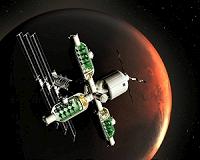 |
Washington DC (SPX) Apr 27, 2011 Remember life before cell phones? Or GPS? Or tablet computers? Kind of hard, isn't it? Air traffic management researchers feel the same way about life before the Future ATM (Air Traffic Management) Concepts Evaluation Tool, or FACET. FACET is a computer program developed by NASA that generates simulations for managing air traffic scenarios. It provides a "big picture" view of what's happening in the skies overhead. For any given moment in time, it can show thousands of aircraft swarming through our national airspace. With each aircraft represented as a tiny icon, a FACET simulation can look like an "ant farm in the sky," with aircraft clustering around major airports like ants targeting a drop of peanut butter. You may have seen video generated from FACET on the morning news during air travel outlook reports. Recently, the creators of this simulation software at NASA's Ames Research Center in California won NASA's 2010 Government Invention of the Year. The award, presented by NASA's Inventions and Contributions Board, is given to inventions that have made a significant contribution to NASA's goals and to broader communities; in this case, the aeronautics community. Nominations are rated on use, creativity, benefits to the community, and overall significance to humankind. "As the world's population grows and air travel demand increases, our airspace will become more crowded," said Banavar Sridhar, NASA senior scientist for Air Transportation Systems. "FACET helps air traffic management researchers find ways to increase airspace capacity and establish more efficient routes with the least impact on the environment, thereby saving fuel and minimizing emissions." One of the best things about FACET is that it doesn't need supercomputers to run, even when asked to crunch data from thousands of flight plans. The software can operate on a single computer, which was a big leap forward that really helps researchers. FACET can model current traffic patterns to see where improvements could be made, or model entirely new patterns that result from new flight operations techniques, like new merging and spacing rules, weather avoidance techniques, or approach patterns into airports. How does it work? FACET uses aircraft performance profiles, airspace models, weather data, and flight schedules to model trajectories for the climb, cruise, and descent phases of flight for each type of aircraft. Then a graphical interface displays the traffic patterns in two and three dimensions, under various current and projected conditions for specific airspace regions or over the entire continental United States. You'll see examples of all of these different models in the video linked from this page. According to FACET team members, the software has become a valuable tool for Federal Aviation Administration traffic flow managers and commercial airline dispatchers. They use FACET technology to do real-time operations planning by combining live air traffic data from FAA radar systems and weather data from the National Weather Service to create a real-time big picture of what's happening in the air. With that information, airspace system operators can reroute flights around congested airspace and severe weather to maintain safety and minimize delay. This is one big picture that's having a big impact on air travel.
Share This Article With Planet Earth
Related Links FACET Space Tourism, Space Transport and Space Exploration News
 NASA Device Inducted Into Space Technology Hall Of Fame
NASA Device Inducted Into Space Technology Hall Of FameHouston TX (SPX) Apr 20, 2011 A rotating device developed by NASA inventors to grow better living tissue specimens was inducted into the Space Technology Hall of Fame Thursday, April 14. The Space Foundation honored the NASA team who created the device, which promises help for several diseases, during a ceremony at the 27th National Space Symposium in Colorado Springs, Colo. Developed in 1986 by a group of NASA enginee ... read more |
|
| The content herein, unless otherwise known to be public domain, are Copyright 1995-2010 - SpaceDaily. AFP and UPI Wire Stories are copyright Agence France-Presse and United Press International. ESA Portal Reports are copyright European Space Agency. All NASA sourced material is public domain. Additional copyrights may apply in whole or part to other bona fide parties. Advertising does not imply endorsement,agreement or approval of any opinions, statements or information provided by SpaceDaily on any Web page published or hosted by SpaceDaily. Privacy Statement |